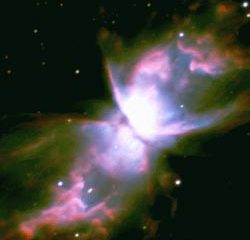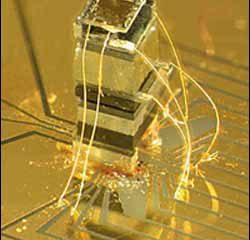Physics and Astronomy
This area deals with the fundamental laws and building blocks of nature and how they interact, the properties and the behavior of matter, and research into space and time and their structures.
innovations-report provides in-depth reports and articles on subjects such as astrophysics, laser technologies, nuclear, quantum, particle and solid-state physics, nanotechnologies, planetary research and findings (Mars, Venus) and developments related to the Hubble Telescope.

The first detection of magnetic fields in the central stars of four planetary nebulae
For the first time, a team of astronomers based in Germany has detected the presence of magnetic fields in the central stars of four planetary nebulae. Planetary nebulae are expanding gas shells that remain after Sun-like stars eject their outer layers at the end of their lifetimes. It is a long-standing and unsolved mystery why 80% of all planetary nebulae are not spherical. Theories suggest that magnetic fields play a role in shaping planetary nebulae. The team, led by Stefan Jordan, has now

Scientists prepare for Huygens descent on Titan
University of Arizona scientists, working on one of the most stunning robotic space missions ever attempted, head for Germany next week.
Their experiments ride on the Huygens probe to Saturn’s giant moon, Titan, part of the four-year NASA/European Space Agency/Italian Space Agency Cassini Huygens mission to the Saturn system.
The probe separated from the Cassini spacecraft early Saturday, Dec. 25, 2004, central European time (or about 8:30 p.m. Dec. 24, Arizona ti

Giant telescope will keep an eye on planets in other solar systems
MIT astrophysicists and their colleagues are excited about the latest milestone toward developing a giant telescope that among other things will allow direct observations of planets orbiting stars in solar systems beyond ours.
On Dec. 13 the Carnegie Observatories of the Carnegie Institution signed an agreement with the University of Arizona’s Steward Observatory Mirror Lab to produce the first mirror for the Giant Magellan Telescope (GMT). The telescope will have a diameter of

Royal Astronomical Society – January Astronomy/Space Digest
SPACE DIGEST: JANUARY 2005
This release contains a summary of some significant astronomical and space events that will be taking place during January. It has been written in order to assist the media in planning and researching future stories related to space science and astronomy, particularly those with UK involvement. It is not intended to be fully comprehensive. Dates and times may be subject to change.
EINSTEIN YEAR
2005 is Einstein Year, the UK’s contribution to

Chip-scale magnetic sensor draws on mini clock design
A low-power, magnetic sensor about the size of a grain of rice that can detect magnetic field changes as small as 50 picoteslas–a million times weaker than the Earth’s magnetic field–has been demonstrated by researchers at the National Institute of Standards and Technology (NIST). Described in the Dec. 27 issue of Applied Physics Letters,* the device can be powered with batteries and is about 100 times smaller than current atom-based sensors with similar sensitivities, which typically wei

Huygens begins its final journey into the unknown
The European Space Agency’s Huygens probe was successfully released by NASA’s Cassini orbiter early this morning and is now on a controlled collision course toward Saturn’s largest and most mysterious moon, Titan, where on 14 January it will make a descent through one of the most intriguing atmospheres in the solar system to an unknown surface.
The separation occurred at 02:00 UTC (03:00 CET): A few minutes after separation, Cassini turned back to Earth and relayed back informati